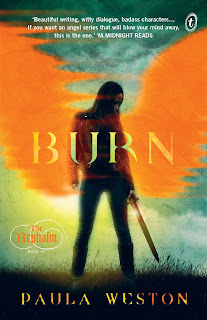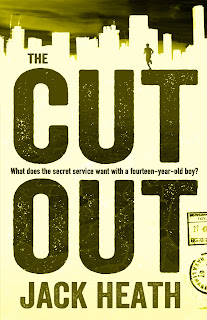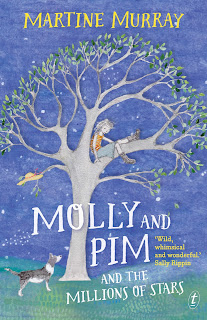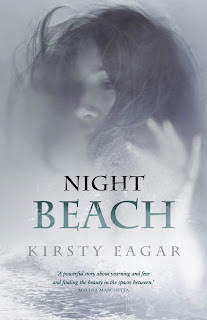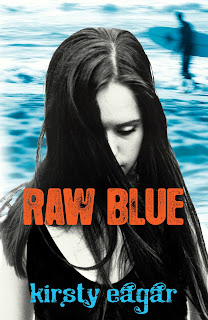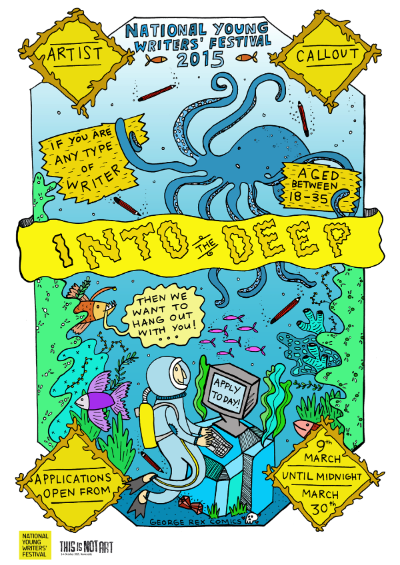new posts in all blogs
Viewing Blog: Steph Bowe's Hey! Teenager of the Year, Most Recent at Top
Results 1 - 25 of 575

A blog about reading and writing YA fiction by 15-year-old author Steph Bowe.
Statistics for Steph Bowe's Hey! Teenager of the Year
Number of Readers that added this blog to their MyJacketFlap: 3
Suddenly, Gaby remembers everything.
For a year she believe she was a backpacker chilling out in Pandanus Beach. Working at the library. Getting over the accident that killed her twin brother.
Then Rafa came to find her and Gaby discovered her true identity as Gabe: one of the Rephaim. Over a hundred years old. Half angel, half human, all demon-smiting badass and hopelessly attracted to the infuriating Rafa.
Now she knows who faked her memories, and how—and why it’s all hurtling towards a massive showdown between the forces of heaven and hell.
More importantly, she remembers why she’s spent the last ten years wanting to seriously damage Rafa.Enjoyable, epic and vividly realised,
Burn is a satisfying conclusion to the Rephaim series; a series which, I believe, has become stronger with every instalment. It takes well-worn concepts in paranormal fiction (there are a lot of fallen angels in YA) but still manages to offer a fresh perspective and solid mythology. I think the setting in particular is wonderful in this novel; it incorporates international locations while still having a distinctly Australian edge.
I have a little trouble reviewing paranormal fiction, largely due to the fact that I read a great deal more on the contemporary end of the spectrum and tend to prefer stories set in the real(er) world; I worry that I am not, perhaps, the ideal audience, due to my low tolerance level for melodramatic supernatural creatures and over-long series. I need not have worried this would be the case with
Burn; this novel is fast-paced and melodrama is kept to a minimum. Nothing is excruciatingly drawn-out as I think can be a temptation for writers with series that feature extensive casts of characters with complex histories. The ending is hopeful, and though a bit sentimental for my tastes, it's a fitting conclusion.
If you enjoy paranormal YA/novels about fallen angels, and are looking for your new favourite series, this one is well worth checking out. (Now that the final novel has been published, there's no painful wait for the next instalment - nothing to stop you from binge-reading the entire series in one go, if you like.) If you read the first book in the Rephaim series and aren't sure whether to pick up the next, do.
Burn is my favourite novel in the series; I especially loved the cinematic battle scenes toward the end. This is exactly the sort of paranormal YA I love, and I look forward to seeing what Paula Weston writes next.
Burn on the publisher's website.

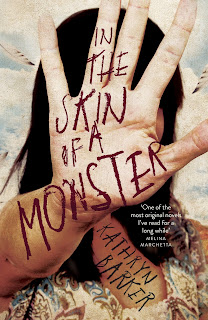 Three years ago, Alice's identical twin sister took a gun to school and killed seven innocent kids; now Alice wears the same face as a monster. She's struggling with her identity, and with life in the small Australian town where everyone was touched by the tragedy. Just as Alice thinks things can't get much worse, she encounters her sister on a deserted highway. But all is not what it seems, and Alice soon discovers that she has stepped into a different reality, a dream world, where she's trapped with the nightmares of everyone in the community. Here Alice is forced to confront the true impact of everything that happened the day her twin sister took a gun to school ... and to reveal her own secret to the boy who hates her most.
Three years ago, Alice's identical twin sister took a gun to school and killed seven innocent kids; now Alice wears the same face as a monster. She's struggling with her identity, and with life in the small Australian town where everyone was touched by the tragedy. Just as Alice thinks things can't get much worse, she encounters her sister on a deserted highway. But all is not what it seems, and Alice soon discovers that she has stepped into a different reality, a dream world, where she's trapped with the nightmares of everyone in the community. Here Alice is forced to confront the true impact of everything that happened the day her twin sister took a gun to school ... and to reveal her own secret to the boy who hates her most.
This is the weirdest book I have read all year and I have read some weird books this year (weird books are my favourite books). The majority of this novel occurs in a dreamscape. Literally. Not a metaphor. This dreamscape that Alice finds herself in fills, every night, with the nightmares of the people of her town. These appear in bubbles which, if popped, release nightmarish creatures and dream-versions of real people into the dream realm. I really love the concept (dream realms are my favourite realms) and the setting is vividly expressed. It's creepy and atmospheric and surreal.
I think what's really extraordinary about this novel is the way it so smoothly incorporates the bizarre and the realistic. It's both fantasy and contemporary; everything that happens in the dreamscape is inextricably linked to Alice's real life tragedy. I think writing about youth and crime requires a bit of gumption; it's so easy to mishandle or accidentally glorify terrible things in fiction, seeing as so much of the experience of a novel is dependent on the reader. I don't believe that people who write for teenagers have some sort of duty to protect or educate children, and I think any story that is agenda-driven is bound to fail, but glorifying violence is never a good look. In the Skin of a Monster features a protagonist whose twin committed a mass murder, and is predominantly about how Alice (and other people affected) comes to terms with this; considering the profoundly difficult subject matter, I think the themes of grief and loss and trauma are all explored frankly but still tactfully. I had a few little niggles with plot points that didn't quite ring true to me, but ultimately I was impressed; an awesome concept, really well-executed. It definitely offers something different, and that's a very welcome addition to YA fiction, in my opinion.
It's surprising and engaging and original. It's a dark novel, but there's still a hint of hopefulness at the end (I wasn't too depressed after I finished reading). One for older YA readers. Definitely worth a look if you enjoy both fantasy and contemporary YA.
In the Skin of a Monster on the publisher's website.



Fero isn't a spy.
But he looks exactly like someone who is: Troy Maschenov - a ruthless enemy agent.
But what starts as a case of mistaken identity quickly turns into a complicated and dangerous plan. Fero is recruited to fight for his country. He will have to impersonate Troy, enter enemy territory, hunt down a missing agent and bring her home in time to prevent a devastating terror attack.
Fero is in way over his head. Hastily trained, loaded up with gadgets and smuggled across the border, he discovers the truth about espionage.
Getting in is easy. Getting out alive is hard.The Cut Out is set in Besmar and Kamau, two small countries wedged between Ukraine and Russia. I was not 100% sure that these were fictional countries, so I may have scrolled around on Google Maps for a bit, thinking perhaps there's
some basis in reality. Which I think speaks highly of the attention to detail and authenticity when it came to the setting. Either that, or my total inability to distinguish between fiction and reality. It requires some suspension of disbelief to buy that a fourteen-year-old who has been picked up off the street would be sent off on a secretive mission within a matter of hours, even in a foreign (and fictional) country; it becomes clear why this occurs at a later point, but in the meantime I was very concerned for Fero's welfare. Maybe I'm getting old.
While it's fast-paced and action-packed and all those adjectives an adventure novel for young people should be, I think it also explores themes that are relevant in the real world with quite a lot of nuance and subtlety - like how conflicts change depending on your perspective, and how information is manipulated by the media (I was reminded of
1984, and how the country they were at war with, and had always been at war with, changed on a regular basis). Having read Jack Heath's novels since 2008, I think it's clear how much he has developed as a writer - even though he continues to write in the same genre, there's nothing stagnant about his work. I think it can be a risk in any genre for certain writers, once finding success, to keep producing the same novel every year; that's not the case here.
I think a lot of kids go through a phase of wanting to be a spy - as a ten-year-old I loved the
Max Remy: Superspy series (I met Deb Abela, the author, when I was fifteen, and I almost fainted), and was obsessed with spies and codes and eavesdropping.
The Cut Out would especially appeal to these readers. It has some very intense scenes, so I'd recommend it for upper primary readers and up; I think my twelve-year-old self would probably enjoy it most, but it depends on the reader. It certainly appeals to me as a twenty-one-year-old reader, too.
I'm very much looking forward to the sequel to
The Cut Out, and seeing where Fero's story goes next. Mainly I hope there's more twists. The twists are the best part.
The Cut Out on the publisher's website.

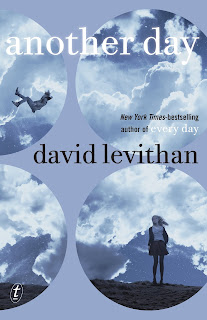 Every day is the same for Rhiannon. She has accepted her life, convinced herself that she deserves her distant, temperamental boyfriend, Justin. She’s even established guidelines by which to live: Don’t be too needy. Avoid upsetting him. Never get your hopes up.
Every day is the same for Rhiannon. She has accepted her life, convinced herself that she deserves her distant, temperamental boyfriend, Justin. She’s even established guidelines by which to live: Don’t be too needy. Avoid upsetting him. Never get your hopes up.
But one morning everything changes. Justin wants to be with her for the first time, and they share a perfect day—a perfect day Justin doesn’t remember the next morning.
Confused, depressed and desperate for another great day, Rhiannon starts questioning everything. Until a stranger tells her that the Justin she spent that day with—the one who made her feel like a real person—wasn’t Justin at all.
Another Day is a companion novel to Every Day, which I loved, and features the same events told from the perspective of love interest Rhiannon. You can read Another Day even if you haven't read Every Day, in fact, I think you should read Another Day first.
Basically it's about a person, A, who wakes up every day in a different body, who falls in love with a normal human being, Rhiannon. Which is problematic. It's a compelling concept but A's perspective is naturally the more interesting one, seeing as Rhiannon is consistently the same person. And a person who is frustrating in her inability to stand up for herself, even if she does seem like an accurate reflection of a real sixteen-year-old. She's likeable, but she never really seems to be in charge of her own story, instead having her life controlled either by her boyfriend Justin, or by mysterious (ghosty?) A; I would've preferred a story where she realised she was perfectly okay on her own, without a boy, or a genderless spirit, having to love and validate her. But that's just the sort of story I would like, and what the story actually is is still engaging. It evokes obsessive teenage romance very well. It's certainly very readable, conversational in tone while still being well-written.
Rhiannon is a well-developed character in her own right; this isn't a shameless money-grab Fifty Shades of Grey as-told-by what's-his-name or gender-flipped Twilight, but an engaging story in it's own right, offering a different perspective of the events. It explores gender and sexual orientation in a really interesting way; things that couldn't, to the same degree, be explored from A's perspective. It's definitely worth reading, and it functions wonderfully as contemporary YA with a paranormal twist, but it pales a little next to Every Day, which I thought was a real stand-out. The story I really wanted to read was what happens after the end of Every Day, rather than the same events from Rhiannon's perspective... fortunately that sequel is going to be published.
That said, this is an enjoyable novel with an authentic teenage voice, and it's pretty tricky to stop reading it. I'd recommend it to fans of both contemporary YA and paranormal YA; it combines the two wonderfully. The concept is brilliant. If you liked Every Day, you'll like this, and vice versa. And I really, really want to know what happens next.
Another Day on the publisher's website.



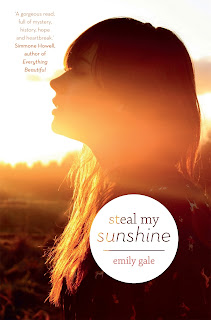 During a Melbourne heatwave, Hannah's family life begins to distort beyond her deepest fears. It's going to take more than a cool change to fix it, but how can a girl who lives in the shadows take on the task alone?
During a Melbourne heatwave, Hannah's family life begins to distort beyond her deepest fears. It's going to take more than a cool change to fix it, but how can a girl who lives in the shadows take on the task alone?
Feeling powerless and invisible, Hannah seeks refuge in the two anarchists of her life: her wild best friend, Chloe, and her eccentric grandmother, Essie, who look like they know how life really works.
But Hannah's loyalty to both is tested, first by her attraction to Chloe's older brother, and then by Essie's devastating secret that sheds new light on how the family has lost its way.
Even if Hannah doesn't know what to believe in, she'd better start believing in herself.
I can't stop this amazing one-hit wonder from playing in my head while I'm working on this review (1999... what a year for music). Trouble is, that song isn't right for the tone of this novel. And now I'm trying to work out what song is right I've discovered that's an impossible task and I can't possibly find the perfect song.
You can't tell but I've just spent half an hour trying to find the perfect song to match this novel and it's just not happening. The best I can do is suggest a combo of One Crowded Hour by Augie March and Songbird by Bernard Fanning and hope that conveys it. Musically, rather than lyrically. It's got all this aching sadness, fairly heartbreaking in parts, but then that hope at the end. I guess I should write the review now.
Hannah is lovely: shy, uncertain and yearning, a character whom I think a lot of young readers will be able to relate to. Difficult family dynamics are explored with realism and subtlety, as Hannah's family crumbles around her. The characterisation is excellent - every character is unique and flawed, from Hannah's sweet and tortured dad, to her (understandably) rage-filled mum, to her out-there best friend Chloe. (I was furiously angry with her mother and brother, and their totally uncalled for meanness towards Hannah. Why would you be so awful? Hannah's a sweetheart, gosh.)
The unraveling of the mystery in Hannah's family, allowing Hannah to understand why things are so difficult between Essie and her daughter (Hannah's mum), kept me reading into the early hours of the morning. Essie is a wonderful character, and I could so clearly picture her and her house. Her story is the most compelling part of the novel, and reads as very authentic. It's incredibly tricky but important subject matter - single mothers being forced to give up their babies, something that occurred for decades in Australia's not-so-distant history - and is dealt with so well. Essie's narrative is at times harrowing, often heartbreaking, with a distinct and engrossing voice. It never feels like it's being educational, but I think it would be a great novel to study in school, and not just because of the historical content.
While there is romance (Hannah has a crush on her best friend's older brother, Evan), the romance isn't even really about the romance - it's about Hannah working out who she is and what she wants, instead of being a passive observer in her own life. I think it's a much more true-to-life depiction of teenage romance than a lot of YA. Similarly, her friendship with Chloe - and the subsequent breakdown of it - reflects the difficulties of real-life teenage friendships; where, sometimes, friends simply outgrow each other.
If you expect things to be perfectly resolved, you'll be disappointed; Steal My Sunshine is realistic in that it depicts the true messiness of life. Steal My Sunshine blends the historical and the contemporary perfectly. It's a novel with huge sadness and a lot of heartbreak, but it's ultimately hopeful. Immensely readable.
Steal My Sunshine on the publisher's website



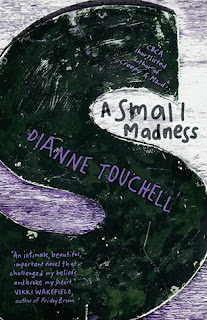 Rose didn't tell anyone about it. She wondered if it showed. She looked at herself in the mirror and turned this way and then that way. She stood as close to the mirror as she could, leaning over the bathroom basin, looking into her own eyes until they disappeared behind the fog of her breath. Looking for something. Some evidence that she was different now. Something had shifted inside her, a gear being ratcheted over a clunky cog, gaining torque, starting her up. But it didn't show. How could all of these feelings not show? She was a woman now but it didn't show and she couldn't tell anyone.
Rose didn't tell anyone about it. She wondered if it showed. She looked at herself in the mirror and turned this way and then that way. She stood as close to the mirror as she could, leaning over the bathroom basin, looking into her own eyes until they disappeared behind the fog of her breath. Looking for something. Some evidence that she was different now. Something had shifted inside her, a gear being ratcheted over a clunky cog, gaining torque, starting her up. But it didn't show. How could all of these feelings not show? She was a woman now but it didn't show and she couldn't tell anyone.
This book. Intense. Horrifying. Incredibly well-written. (It's the first time in ages I've read a YA novel where I had to look up words, which I love - learning new words is the best.) I think just as many readers of adult literary fiction would enjoy this as readers of YA fiction (I think a lot of YA fiction transcends what people stereotypically think of as YA fiction - this novel is a great example of that). I can't say I enjoyed it, because it deals with events that are downright awful, and characters that behave in some pretty horrendous ways, but it's an impressive novel.
Rose's best friend Liv is the most likeable character (and the most sensible). The actions of Rose herself are often incomprehensible (hence the 'madness' bit). Credibility stretches a little when it comes to the ignorance around sex and pregnancy displayed by the central characters, given they're seventeen-year-olds in modern Australia, who seem middle-class and not strictly religious. (It had a feel of being set in the past, though it wasn't; had it been, it might have been more believable.) It reads as a cautionary tale, but it's not at all moralising.
If you're sensitive to issues around teenage pregnancy and miscarriage, and you like your YA novels cheerful and uplifting, this might be one to miss. I'm not prone to recommending younger readers away from certain novels - I read YA fiction from the age of ten, and though I liked to steer away from dark, unpleasant stuff back then, but that might not be the case for all readers - as you'd know your own limits in terms of novel content better than I would, obviously. That said, I do think older teenaged readers and adult YA readers are much more likely to appreciate this novel. It's a very compelling read, and the writing is magnificent, but it's also incredibly confronting.
A Small Madness on the publisher's website



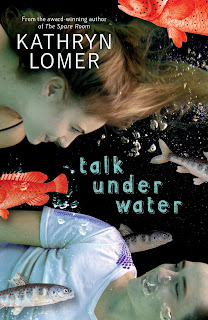 Will and Summer meet online and strike up a friendship based on coincidence. Summer lives in Will's old hometown, Kettering, a small Tasmanian coastal community. Summer isn't telling the whole truth about herself, but figures it doesn't matter if they never see each other in person, right?
Will and Summer meet online and strike up a friendship based on coincidence. Summer lives in Will's old hometown, Kettering, a small Tasmanian coastal community. Summer isn't telling the whole truth about herself, but figures it doesn't matter if they never see each other in person, right?
When Will returns to Kettering, the two finally meet and Summer can no longer hide her secret – she is deaf. Can Summer and Will find a way to be friends in person even though they speak a completely different language?
Talk Under Water is told through emails, letters, Facebook posts and the first-person narratives of both Will and Summer. It's an easy read, with straightforward writing. Summer's deafness is very well depicted, and the amount of knowledge by the author of sign language and Deaf culture is clear (Minor grammatical errors in Summer's writing, since English is her second language, was a great touch). It's the sort of novel I would have loved to have studied in the early years of high school - it's engaging, readable and there are so many interesting themes. As well as Summer's deafness, she's still grieving for her dad, and Will's dealing with family breakdown, too. It's a very accessible story, and includes a lot of information about deafness and sign language without ever being preachy or over-the-top; it's very much part of the narrative, and the story doesn't suffer for its inclusion.
The dual narrative allows the reader to empathise and connect with both central characters, and the secondary characters are well-developed and relateable, too - I really felt for Will's dad and Summer's mum, who have both lost their partners. Will's old best friend Cully is ignorant about deafness, and continues to be even once he meets Summer, and I think the difficulties of Will's friendship with Cully is something a lot of teenaged readers will be able to relate to - at least those that have experienced the shift in friendships as you get older as people change and grow apart I was a bit concerned about how much information Will and Summer shared about their respective lives, where they lived, et cetera when they initially communicated online - even though I as the reader knew they were both teenagers, from their perspective the other could easily have been a middle-aged weirdo. My worries about stranger danger were probably my greatest concern with the novel (I don't want anything bad happening to the characters, gosh!).
Talk Under Water is an enjoyable read, where the stakes aren't ever really that high - the major problems stem from miscommunication between the two central characters, which resolves quickly - which lends it realism, though not a lot of conflict. I'd recommend it for younger teenage readers (perhaps even readers in the later primary school years); while there's a very sweet romance story at the centre of this novel, it's very much secondary to the friendship that develops between the characters, both of whom read as being quite young. It's a nice, thoughtful, heart-warming novel, and it wonderfully reflects the real-world diversity of young people, which is something we always need more of in YA fiction.
Talk Under Water on the publisher's website.



The
NYWF program has been announced, which is fairly exciting, since I'll be there this year! It's on from October 1 to 4 in Newcastle, and it promises to be excellent (and it's all free!). Here's a bit of a blurb on the festival from their website:
NYWF is Australia’s largest gathering of young and innovative writers working in both new and traditional forms including zines, comics, blogging, screenwriting, poetry, spoken word, hip hop, journalism, comedy, songwriting and prose. This year’s festival is set to be our biggest yet and will deliver an assortment of performances, debates, workshops, panels, readings, in conversations and roundtables on topics that push the envelope further and further.
I'll be talking on these two panels (there are so many amazing events, it's ridiculous - the program is
here):
Publishing How ToWith: Jennifer Dougherty, Steph Bowe, Samantha Forge, Eliza Henry-Jones
Everyone wants to know how to get their book published, right? But what does a good proposal look like? And do you need an agent or not? These editors and publishers and writers share their tips and tricks of the trade, from navigating the dreaded slush pile, to how to pitch.
Sat, 3 Oct 2015, 2pmVenue: The Royal Exchange
YA Genre: Ahead of the CurveHost: Jennifer Dougherty. With: Steph Bowe, Gabrielle Tozer, Lynette Noni
YA is often on the forefront of new movements when it comes to cutting edge themes, character diversity and the inclusion of debut authors into the fold. Why is it that so many young authors cut their teeth on YA? And why is YA so often a sounding board for big issues?
Sunday, 4 Oct 2015, 3pmVenue: The Royal Exchange
Check out the
NYWF website to see all the other awesome people who'll be appearing. I hope to see you there!

I'll be running workshops with years 7-9 students as part of Meanjin Writers' Day Camp on September 5 in Mt Gravatt! I'll be presenting alongside Kyrra Wilks, author of fantasy adventure novel The Seven - a very inspiring young writer!
If you're in years 7-9 in South-East Queensland and keen on writing, or know someone who is, you should register! You can find out more on the Australian Literacy Educators’ Association website. Here's a bit more info, from their site:
The Brisbane Meanjin Local Council of the Australian Literacy Educators’ Association (ALEA) conducts an annual writers' camp to encourage and develop talented young writers. This year students in Years 7, 8 and 9 from both state and non-state schools are invited to attend and have the opportunity to work with a well-known and established author as well as an emerging author.
WHEN: Saturday 5th September 2015
WHERE: Yarranlea Primary School which is located on the Mt Gravatt Campus of Griffith University, Brisbane
AUTHORS: Steph Bowe and introducing Kyrra Wilks
PLANNED ACTIVITIES:
- Meeting the invited authors and hearing about their writing and stories
- Working with the authors to help you with your own writing projects
- Exploring writing, talking about writing, sharing writing ... and writing!
- Finding out from authors how books get to print
- Social activities with new friends

 Tom survived a devastating flood that claimed the lives of her sister and parents. Now she lives with Bill in his old shed by the lake. But it’s time to move out—Tom is pregnant with Bill’s baby.
Tom survived a devastating flood that claimed the lives of her sister and parents. Now she lives with Bill in his old shed by the lake. But it’s time to move out—Tom is pregnant with Bill’s baby.
Jonah lets her move in with him. Mrs Peck gives her the Fishmaster Super Series tackle box. Nana is full of gentle good advice and useful sayings.
And in her longing for what is lost, Tom talks to fish: Oscar the carp in the pet shop, little Sarah catfish who might be her sister, an unhelpful turtle in a tank at the maternity ward. And the minnow.
A novel very unlike anything else I have read, both incredibly beautiful and incredibly sad. Tom has an innocence that is both lovely and heart-wrenching. So many tragic things befall her (losing her family in a flood is only the beginning), it's amazing that the story manages to be uplifting, in the end. Tom is a character with whom I sympathised, and I loved that she spoke to fish (it reminded me a little of Big Fish, the poignancy of it, or the surrealness, or maybe the use of fish as metaphors, or all three. That was my favourite film when I was ten. I must have watched it a hundred times). Her grandmother is the sweetest, and so is Jonah. Mrs Peck is horrendous, but Bill is most horrendous of all. The town itself is beautifully drawn and distinctly Australian, but still with a sense of being disconnected from the rest of the world (likely due to Tom's perspective).
It's authentic despite the surreal aspects, but if you come to this novel expecting standard contemporary YA, you'll be disappointed. It doesn't moralise or offer life lessons or clearly explain particular situations (many, many details remain vague, like those of the flood or how Tom came to live with Bill). The plot is not clear or neat. The voice of Tom and her journey are compelling enough. It reminded me of As Stars Fall by Christie Nieman, which was published around the same time and has a similar slow-burning moody atmosphere and surreal aspects expertly weaved into a realistic story.
The Minnow is original and unconventional and exquisitely written and heart-breaking/mending. It tackles huge, difficult events with aplomb and subtlety. This is, again, one of those novels that should hardly be limited to teenage readers. I think many adults will enjoy this, even those that don't fancy themselves as readers of YA.
The Minnow on the publisher's website
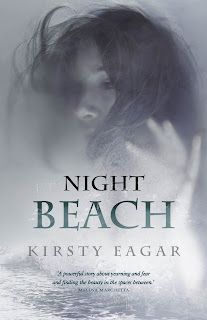 Imagine there is someone you like so much that just thinking about them leaves you desperate and reckless. You crave them in a way that's not rational, not right, and you're becoming somebody you don't recognise, and certainly don't respect, but you don't even care.
Imagine there is someone you like so much that just thinking about them leaves you desperate and reckless. You crave them in a way that's not rational, not right, and you're becoming somebody you don't recognise, and certainly don't respect, but you don't even care.
And this person you like is unattainable.
Except for one thing . . .
He lives downstairs.
Abbie has three obsessions. Art. The ocean. And Kane. But since Kane's been back, he's changed. There's a darkness shadowing him that only Abbie can see. And it wants her in its world.
A Gothic story about the very dark things that feed the creative process, from the winner of the 2010 Victorian Premier's Literary Award for young adult fiction.
This is a case where you can judge a book by its cover. The novel is atmospheric and spooky and the cover suits it perfectly. This novel is weird, which I love, dark and strange and interesting. Abbie is not always a likeable character, or a good decision-maker (she is obsessive to an incredibly worrying degree), and Kane, with whom she is obsessed, is often downright awful. It's paranormal, I suppose, but not your typical paranormal - there's not clear-cut romance or predictable plotlines. It is both real and unreal (and quite surreal, too, now I think about it).
It's distinctly different from both of Eagar's previous novels - Saltwater Vampires is more paranormal and more humorous, and Raw Blue is much more realistic and written in a more straightforward style. I think there are quite a number of writers from whom you can generally expect something similar with each book - whether that's the writer's doing or the publisher's is hard to tell. That's both a good thing and a bad thing. It's good in that if you discover a book you love, then there's more where that came from in the writer's back catalogue, and it makes it easier to clearly define a writer's style. It's bad in that some writers can become predictable. What I think is obvious from Eagar's novels is that she's a writer who is constantly developing and challenging herself, and as a result each of her novels published so far is unique. So I can't necessarily say if you loved Raw Blue, you'll love Night Beach, too - the writing style is more complex, the plot is supernatural, and the central character is far less sympathetic - but I can say that Night Beach is brilliant.
My greatest disappointment with the novel (look away now if you want to avoid a spoiler, though it's not a major one) is that a dog is killed, which I didn't think was entirely necessary. There are certain things in novels that I can't stomach, and this is one of them. (Though it speaks to how involved I was in the story that I found that event so horrendous; if it were a poorly executed novel and it had felt inauthentic, it wouldn't have bothered me as much.)
This book was published three years ago, so I'm a little disappointed I didn't read it until just recently - I think I have a tendency to favour contemporary in my YA reading. If this sounds like the sort of novel you'd like (weird/dark/intense) then do not skip over it. It is beautifully written, and very compelling, and different and strange and so worth reading.
Night Beach on the publisher's website.



Molly has a strange life. Her mama collects herbs at dawn and makes potions, her father and brothers have gone away, and her house feels like a gypsy caravan.
Molly doesn’t want to know anything about herbs and potions. She wishes she could be more like her best friend, Ellen, who has a normal family and a normal house. But she is also secretly interested in Pim, who is inquisitive and odd and a little bit frightening.
When Molly’s mama makes a potion that has a wild and shocking effect, Molly and Pim look for a way to make things right, and Molly discovers the magic and value of her own unusual life.
This novel is The Loveliest. Sweet and splendid and magical, while still being of-this-world. Molly longs to be as normal as her friend Ellen (who gets muesli bars in her lunchbox and doesn't have a mum that wanders about the woods barefoot, collecting herbs for potions) and this is something I think young readers will definitely relate to (everyone has thought at some point "my family is the weirdest" - eventually you realise everyone's family is weird and that's okay and sometimes even great).
Molly does work out that she's pretty lucky to have her slightly odd mum, but only once something pretty terrifying happens. I don't want to give anything away (I think it's better when stories are surprising), so I'll leave it at that. Even though Pim features in the title (and Pim, with his interesting trivia and perspective of the world, is a great character), he doesn't heavily feature in the book. It's a story about friendship, but most of all it's about Molly learning to appreciate her mum and their strange life. (The fact that her father and twin brothers had mysteriously vanished in Cuba was such an odd but intriguing detail, and one that makes me hope there'll be another book about Molly, in which she finds them!)
There are so many sweet characters (apart from the incredibly horrendous neighbours, Ernest and Prudence Grimshaw), but I especially love Molly's mum, and Ellen (I would be friends with Ellen. She is so nice and
sensible). The lovely little illustrations and glossary of herbs and such at the end of the book are a beautiful touch. I really quite enjoyed it, and I would've absolutely adored it when I was ten.
(How splendid is the cover? It's got lovely sparkly bits, in real life - have a look at
Cait's review at Paper Fury for some lovely photos of it. Am I overusing the word lovely? That's what this book is.
The Bookish Manicurist's painted a gorgeous manicure to match it. And now I'm linking to other reviews, I can't really stop myself: I love
this review from a 9-year-old reader, as well as
Danielle's thoughts at Alpha Reader on this book and middle-grade fiction in Aus.)
Molly and Pim and the Millions of Stars on the publisher's website
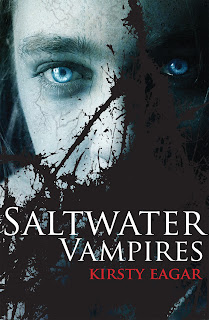 He looked to the sky, praying for rain, a downpour, some sign from the heavens … But all he saw was the bloated white face of the moon smiling down on him … And the sky around it was cold and clear and black …
He looked to the sky, praying for rain, a downpour, some sign from the heavens … But all he saw was the bloated white face of the moon smiling down on him … And the sky around it was cold and clear and black …
They made their circle of blood. And only the moon witnessed the slaughter that followed.
For Jamie Mackie, summer holidays in the coastal town of Rocky Head mean surfing, making money, and good times at the local music festival. But this year, vampires are on the festival line-up … fulfilling a pact made on the wreck of the Batavia, four hundred years ago. If their plans succeed, nobody in Rocky Head will survive to see out the new year.
Saltwater Vampires takes a real historical atrocity (the mutiny and massacre of at least 110 people following the 1629 shipwreck of the Batavia) and reimagines it as vampiric turning ritual ('Vampires did it' makes it seem less awful, somehow). The historical angle is well-executed and intriguing. Most of the story occurs in the present day, and centres around Jamie and his friends becoming embroiled in another terrible vampiric plot centred around the local music festival. It's fun and fast-paced and a little bit outlandish, but there's still a sincerity to the story and the relationships between characters.
I loved the setting - an Australian coastal town over the break between Christmas and New Year - which is antithesis of setting in traditional vampire novels (where it is perennially dark, rainy, misty and thunderous in either a) an old time-y European castle complete with bats or b) a vaguely American small town that has frequent mysterious disappearances). The vampire mythology is consistent and credible - plenty of standard vampire stuff with a few little twists. Vampires are able to see the future in mirrors, which is an absolute torment for them, hence why they don't like mirrors, and the fact that they don't need to breathe allows them to live underwater. If you like your vampires sparkly and sexy, this is probably not the book for you - the vampires are creepy and sinister and really not the kind you want to encounter during an evening stroll.
(An aside: the plan of the vampires in this novel reminded me of the plan of the leviathans in season 8 of Supernatural. Juice = Turducken. Plus, the vampirates in the same season are not entirely unlike the saltwater vampires in this novel.)
The things that appealed the most to be about the novel weren't necessarily the things that were emphasised - the story of Jamie and his friends was what the majority of the story centred around, while I really wanted to find out more about the secret vampire society and the motivations and backgrounds of each of the vampires - like further explanation of Jeronimus Cornelisz's obsession with Lucretia Jans, how people get recruited by the vampire organisation (I'm keen on being pale and running really fast and being able to eavesdrop really well, can I join?), that sort of stuff. So it reads more like a contemporary YA, with vampires and sprinklings of history thrown in.
I'd recommend
Saltwater Vampires to younger YA readers (the central characters are fifteen). It's a very enjoyable vampire novel with an interesting historical aspect, that's centrally character-driven - even if you're not a big fan of paranormal fiction, it's still worth picking up.
Saltwater Vampires on the publisher's website.

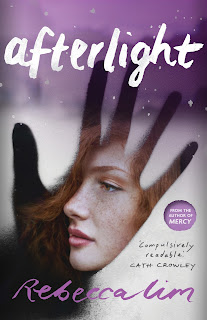 Since her parents died in a freak motorbike accident, Sophie Teague’s life has fallen apart.
Since her parents died in a freak motorbike accident, Sophie Teague’s life has fallen apart.
But she’s just enrolled at a new high school, hoping for a fresh start.
That’s until Eve, a beautiful ghost in black, starts making terrifying nightly appearances, wanting Sophie to be her hands, eyes and go-to girl.
There are loose ends that Eve needs Sophie to tie up. But dealing with the dead might just involve the greatest sacrifice of all.
Dark, thrilling and unrelentingly eerie, Afterlight will take you deep into the heart of a dangerous love story, revealing the otherworldly—and deadly—pull of past wrongs that only the living can put right.
I am like 85% sure Rebecca Lim is not of this world. I don't know how she does it, but she's written a novel about a girl who follows the directives of a ghost and it's somehow believable. Authentic. Ghosts exist. There's these gate-keepers stopping them from getting at us. All of this makes perfect sense. She's got powers, is what I'm saying. I am fully convinced this all could've actually happened. I think this is due to a combination of two things: Sophie's hilarious, unpretentious narration (which reads like a friend telling you what they got up to at the weekend) and the astounding amount of geographical detail (I'd call it world-building but it's Melbourne which I'm fairly sure is not Rebecca Lim's creation - but who really knows, maybe I'm in a Rebecca Lim novel? Disappointing lack of babes/supernatural creatures makes me think this is unlikely).
I stayed up very late reading this novel and it is a very creepy novel and when I went to get a glass of water in the
dark, scary night while reading the
dark, scary book I was DEEPLY CONCERNED that there would be a ghost in the kitchen and/or outside the kitchen window (for some reason, outside the kitchen window is scarier, I don't know why). Fortunately there was not. But. This book: really, really spooky. (After I finished reading, I had weird, disorienting dreams. Possibly due to this book. Possibly due to the fact I usually have weird, disorienting dreams.)
I cannot believe Jordan Haig is not mentioned in the blurb because he's terrific, he's the most terrific character in the book, I can't believe it. Best love interest in a YA novel I've read in recent memory. It's a definite read-in-one-sitting book (both because it is really short and also because it is really compelling). There are some characters that I expected more development of or some resolution to their story, which makes me hope there's a sequel (for instance, Daughtry seemed underutilized - surely he could've helped out a little more?). I thought, at the very least, Claudia P (the very awful bully) would get some sort of ghostly comeuppance (or would that have been cliché? Possibly).
Afterlight doesn't have the same degree of in-depth expansive development as Lim's
Mercy series, but it does have the same fast-paced, punchy thrills of
The Astrologer's Daughter. I'm just very excited to read whatever Lim writes next, sequel or standalone.
Read it if you like:
Underbelly and/or
Goosebumps; spooky stories; quick, compelling reads; paranormal romance/urban fantasy/thrillers or any combination thereof. Just read it. I reckon you'll enjoy it.
Afterlight on the publisher's website.

 Frankie and Joely are best friends. They love each other like no one else can. But when a summer break in the country brings fresh distractions, simmering jealousies and festering secrets, can their friendship survive?
Frankie and Joely are best friends. They love each other like no one else can. But when a summer break in the country brings fresh distractions, simmering jealousies and festering secrets, can their friendship survive?
It’s the holidays and, together, Frankie and Joely board a train and escape the city and their mums for a week of freedom. But when Joely introduces Frankie to her country cousins, Thommo and Mack, it soon becomes clear that something other than the heat is getting under their skin. As the temperature rises and the annual New Years’ Eve party looms closer, local boy Rory stirs things up even more and secrets start to blister. Suddenly the girls’ summer getaway is not panning out how either of them imagined. Will they still be ‘Frankie and Joely’ by the end of their holiday?
I love novels about female friendship and rural Australia and hot summers, and Frankie and Joely has all of these things. The stifling heat and the dusty middle-of-nowhere town are depicted beautifully. The story is told using third-person omniscient - predominantly from the perspectives of Frankie and Joely, but also offering Mack's, Thommo's and Rory's viewpoints. This is a style of narration that is really difficult to get right, and at times, as POV changed from paragraph to paragraph, I felt at a remove from the characters. The stark differences in how Frankie and Joely view each other and themselves make their perspectives the most compelling - had the story instead been told by only one or the other, so much of the exploration of their friendship would be missing, and it wouldn't be as rich or as nuanced a story. I am always fascinated with the awful characters in stories, so more of Rory's point of view and his particular background and motivations would have been terrific; similarly, Mack and Thommo aren't POV characters for particularly much of the story, and I feel they could've contributed more.
Joely's aunt and uncle are the most sympathetic characters of the novel - there's a scene where the aunt makes scones with Joely which is one of the loveliest in the novel (and made me really want to make and eat scones. Which I might do after I finish writing this). Frankie's desire to be accepted, and her love and care for her off-the-rails mum makes her far more likeable than Joely, whose childishness is at times grating. That said, they are fifteen-year-old characters and, knowing actual fifteen-year-olds (and having been fifteen myself), they're very realistically depicted. I think the pettiness and melodramas and general complexities of intense teenage friendship are well-drawn. The girls communicate poorly and behave like idiots and treat each other badly, despite how important the friendship is to both of them, because they're both dealing with their own issues: trying to deal with family and boy dramas and attempting to work out who they are and who they want to be.
It's an easy, enjoyable contemporary Aussie YA read, which I think will appeal most to younger teenaged readers who can identify with Frankie and Joely and the intensities and difficulties of their friendship. If you liked Kate Gordon's Writing Clementine, I reckon you'll like this one, too (and vice versa).
Frankie and Joely on the publisher's website



From 1p.m. till 3p.m. on Sunday July 12th, I'll be appearing at Broadbeach library here on the Gold Coast! Here's what the event is all about:
Take over the library with authors Tristan Bancks, Steph Bowe and Brian Falkner. Share pizza and soft drink and find out why they write, how they write and whether you could write books too.
(OF COURSE YOU COULD WRITE BOOKS TOO, is what I'm going to say. Writing books is the greatest and everyone has awesome story ideas if they have a go at it.)
It's for 12- to 17-year-olds! I am always excited about events for teenage readers (and writers) being held here on the Gold Coast, so this is pretty awesome (I'm looking forward to the pizza!).
SO: if you're a teenage reader on the Gold Coast and wondering what to do on the twelfth of July, you really should come along.
You can register on the library website
here.


Kirsty Eagar is the Sydney-based author of YA novels Raw Blue, Saltwater Vampires and Night Beach, plus Summer Skin, to be published early next year (!!! I am excited about this). She's won the Victorian Premier’s Literary Award for Young Adult fiction and been shortlisted for the NSW Premier’s Literary Awards, the Queensland Literary Awards, the Western Australia Premier’s Awards and a Gold Inky - which should indicate that her novels are pretty terrific. I met Kirsty Eagar at the Somerset Writers Festival in 2011, so I can confirm she is as lovely in real life as she is on the internet.
Being able to ask an author tonnes of questions about their writing process under the guise of it being for my blog - when in actual fact I'm just really curious! - is one of my favourite things about blogging (I hope you love finding out the stories behind stories as much as I do!). Luckily for me, Kirsty took the time to answer all of my very involved questions with really thoughtful, interesting answers - on writing about surfing, reading while writing, exploiting your own fear to create creepy atmosphere, the advice she'd share with herself as a beginning writer, plus more.
--
Steph: I really love that each of your novels are so different from one another (save for the surfing theme - I'm going to ask questions about that shortly!) - from Raw Blue being achingly realistic to Saltwater Vampires being paranormal with historical elements to Night Beach being a terrifically eerie gothic horror story. So I wonder whether you decide before you set out what genre you'll write the next book in, or whether that's something you work out as you write? Genre-wise, do you favour one over the others?
Kirsty: Oh, that’s such a good question. I’d love to know how it works for other people. With Raw Blue and Saltwater Vampires, the genre was part of the initial seed idea. It wasn’t that clear cut for Night Beach. In the beginning, I had it pegged as more of a noir thing, more realistic. But when I decided to include art in the plot, everything changed, because I’ve always loved the Surrealists. Also, the house that Abbie’s living in is borrowed directly from real life – an old place we rented. The swaying chandeliers really happened, likewise that place had no hallway (so each room had two to three doorways) and there was a locked door downstairs. So it was probably the decision to use the house that turned the story gothic. (The house’s saving grace was that it also had a great view – blurry photo below is from the balcony at night: moon over the ocean).
On genre: I have no favourite. I found Saltwater Vampires the most demanding to write, though.

Kirsty: Before I got published I’d written two novels that almost, but not quite, made it, and I’d given up on the whole idea of getting there. But I couldn’t let go of writing, so I decided to just write something that mattered to me. And surfing has given me all the big things in my life (writing, my husband, a home, a community, daily conversation that forces me to remove my head from my … you get the picture) so it had to be in there. In the beginning I struggled with permission, though. But then I realised that a lot of surf writing is from a male perspective, and tends to be about dominating the ocean, whereas I wanted to write about something quieter – just turning up because you love it. That realisation gave me the way in, and a point of difference.
There’s probably always more to write on it, because the hierarchy in the water is an interesting way to explore other themes, like belonging, for example. That said (she says, climbing down from her high horse) there’ll be no more surf writing for at least the next two books. It’s been good to step away from it.
Steph: In Saltwater Vampires, historical events and characters are interpreted through a supernatural lens - what drew you to writing about the Batavia? Are there any other historical events you'd like to reimagine for a novel? Kirsty: I think what made me want to write about it was that it was just such a good story. To this day, Mike Dash’s account of what happened,
Batavia’s Graveyard, is probably my favourite work of non-fiction (his writing is brilliant).
Funny, you ask that second question … I’m related to the explorer Emily Caroline Barnett (nee Creaghe) so I’d like to look at her life either in a novel, or creative non-fiction.
Steph: Do you read while you're working on a novel? Does what you're reading vary based on what you're writing and help inspire your work? Kirsty: Yes and no. I oscillate between lumpy bursts of intense effort in amongst much longer periods of flat line procrastination. So I’m happy to read when I’m flat lining, but I don’t read at all when things are heating up. I’ll read books related to what I’m doing in a research sense, but I try not to cross over with other fiction. Most of the time, I read pretty widely and there’s no rhyme or reason to it. So I might read a sports biography, and then a YA, and then a horror, and then short stories … What inspires me is when you come across writing so good it smacks you in the eyeballs. It makes you realise what’s possible.
Steph: What have you learnt about writing and publishing that you'd share with yourself back when you first started writing? Kirsty: Just. Keep. Working. Set targets and then halve them (annual, monthly, week to week) and keep a record of your hours – it keeps you honest, gives you a feeling of accomplishment, and forces you to focus on the writing. In a business sense, don’t be afraid to ask questions and never be afraid to change things if they’re not working. I think, too, I haven’t always been very mature about handling the post publication side. I let things slide, buried my head in the sand. In terms of interacting with other writers and readers, you should know, Steph, that you have been a role model to me. I very much admire your grace, professionalism, generosity and courtesy. So that’s important, too, focus on the people who are positive.
Steph: Do you outline your novels or make things up as you go along? What's your process like, generally, from idea to finished manuscript? Kirsty: It tends to be pretty loose until I finally get a decent first draft down. I don’t outline formally, only because when I’m writing it changes anyway. But I do have a working idea in my head of where I might be going, and a couple of story beats I want to hit. Each chunk of new writing might contain a couple of hidden gems – like a throwaway line halfway through chapter five that you suddenly realise would work well as a scene, and not just any scene, but your opening scene! So what I call a first draft is heaps and heaps of rewrites and a lot of stops and starts. I find that excruciating, and I always tell myself it’ll be different next time, more organised, but it never is.
Steph: Night Beach is incredibly eerie and atmospheric - what were your inspirations? What advice would you give writers wanting to generate creepy atmosphere in their stories? Kirsty: Thank you! The art in the story was a big inspiration. I took directly from it in places – so, for example, Dorothea Tanning’s
Eine Kleine Nachtmusik. Yes, there’s a point in the story where Abbie’s hair is standing on end like the dolls/girls in that painting, but what I found, the more I looked, was the sense of unease I felt actually came from that door, just so slightly ajar. I drew a lot on the idea of the shadow, too – Jungian psychology and the shadow-self, the unconscious parts of your personality that you don’t acknowledge (so, for Abbie, that might be her sexuality, or residual feelings about her parents’ divorce).

More generally, I am the person who can’t sleep without closing the wardrobe door. I take open stairs two at a time because I’m convinced a hand will suddenly close on my ankle. I haven’t watched a scary movie since I was thirteen; I find them unbearable. So it’s about exploiting your own fears as much as anything else. And my daughters, when they were little, used to come up with some genuinely creepy shit. Also, I was very tired when I wrote that book – it was written between the hours of 10pm and 2am. Being the only one in the house awake meant I could easily scare the crap out of myself!
Steph: There's a lot of really challenging material (to write and to read) in your novels, and very authentic, emotionally honest characters. I think this sort of stuff can be easily mishandled, but everything is dealt with very subtly and realistically. I felt this most especially with Raw Blue. So I wonder how you go about empathising with your characters - are you the sort of writer to whom characters seem very real and drive the story themselves, or do you have to really draw them out and explore the character before being able to write them so authentically? Kirsty: Thank you again, Steph. Yes, they definitely feel real and, I think this is important, they also aren’t me – because you’ve got to get your own ego out of the way. Hopefully that happens during the whole write, rewrite, rewrite, feedback, rewrite, rewrite cycle! But, on the other hand, I think you’ve got to be honest. So you’re invested, you’ve risked something. That said, the characters drive it. I will sit with a scene for a long time now, and wait until my initial urge has passed and a second, better, solution arrives, generated by them. But that’s scary, because you’re always worried it won’t come. How’s that for a not very good answer to your question??? :)
Steph: Do you have a perfect reader in mind as you write? Or do you write for yourself? Does it vary from novel to novel? Kirsty: The eventual decision to go with one thing over another (because there always seems to be two competing ideas when I’m about to start something new) is made to please myself. But once I’m writing, it is about the reader. I don’t know who they are, though. They’re this floaty presence, holy and humbling. Real readers are the motivation to not give up on a story, because you’ve loved this world and these people and you want someone else to share it with you.
Steph: What are you working on at the moment? (Having now read all your novels, I am in that rather unpleasant state of impatiently waiting for the next book - so I hope it will be out soon!)Kirsty: Well, that goes from me to you, too, Steph – waiting! The next one (I have to interrupt myself here to say that for a long time I thought there mightn’t be a next one, so it’s really nice to be able to say that, albeit, not very casually!) comes out early next year. It’s called
Summer Skin. Despite being a beachy sounding title, as I said, there’s no surfing. It’s a uni novel, set in Brisbane (where I went to uni). It’s a bit out there, and I’m terrified.
Thank you for such astute questions Steph, and thank you very much for having me!!!
--
Thank you, Kirsty!
Kirsty writes a terrific
blog, which is well worth checking out - one of her features,
Where the magic happens, is about where writers write, to which I contributed a post, which you can read
here (predictably, it features garden gnomes). I am
ridiculously excited for
Summer Skin - and Kirsty has a
little snippet of it up on her blog.
Here's
my review of Raw Blue, and more info on
Night Beach and
Saltwater Vampires (you'll probably see reviews for each of these here soon).

Carly has dropped out of uni to spend her days surfing and her nights working as a cook in a Manly café. Surfing is the one thing she loves doing … and the only thing that helps her stop thinking about what happened two years ago at schoolies week.
And then Carly meets Ryan, a local at the break, fresh out of jail. When Ryan learns the truth, Carly has to decide. Will she let the past bury her? Or can she let go of her anger and shame, and find the courage to be happy? This is another book I thought I'd reviewed when I first read it years ago. Upon discovering I hadn't, I started doubting whether I'd read it to begin with. (When I was a teenager I read so much half the books fell out of my head.) Once I started reading, my memory was jogged and I knew I had definitely read it: each scene was so vivid in my mind, and I started anticipating the unpleasant parts of the novel before they happened. I found
Raw Blue incredibly realistic, uncomfortably so, and very visceral.
It frustrates me incredibly when some babe shows up in a YA novel and fixes the protagonist and their myriad problems, which I think is unrealistic (and doesn't really solve anything: the protagonist hasn't really grown or dealt with their problems). What is terrific about
Raw Blue is that Carly very much saves herself. The blurb makes it sound a bit sappy, but it's entirely not; her depression and rage and self-loathing are all well-drawn, and her development as a character is gradual and convincing.
What I love best about this novel and what I think makes it so realistic is the cast of characters, all of whom are well-developed and authentic. They don't all necessarily serve the plot (a few of Carly's co-workers could easily have been merged together, for instance, without the story changing) but they make the world of the novel far more representative of real life, and the myriad people we encounter (sometimes unpleasant) and whose lives intersect ours. In
Raw Blue, everyone has a story and a background and things going on in their life (often left unresolved) and the story often meanders as a result, but it's perfect for this book. Of all the characters, Danny is my favourite (a kid Carly meets surfing who has synesthesia and associates people with colours) but I also love Hannah (Carly's salsa-dancing Dutch neighbour).
Carly is a nineteen-year-old character and the novel centres around some very heavy content (always dealt with tactfully, but you may prefer not to read novels in which sexual assault occurs). I'd recommend it to older YA readers and adult readers of YA; this is a prime example of excellent, challenging Australian contemporary YA. (This is a big call, but I'd also say it's the Australian equivalent of Speak by Laurie Halse Anderson. It's that good.)
Raw Blue on the publisher's website
Young Queensland writers are invited to enter the Queensland Premier’s Young Publishers and Writers Awards, part of the 2015 Queensland Literary Awards, for a chance to win $10,000 plus career development support. The award will be presented to two outstanding Queensland writers, aged 18 to 30, who exhibit high quality writing, a track record of publication outcomes and a commitment to developing and sustaining an ongoing career as a writer.
How awesome are the Queensland Literary Awards? (Very, is the answer.) Here's their website, for more details - get onto nominating, if you're a Queensland writer 18-30 who's published a novel/short stories/poetry/etc in the last year. Nominations for the Queensland Literary Awards close 19 June 2015.

 Will anyone hear you cry?
Will anyone hear you cry?
Celia and Alice share everything – their secrets, hopes and the increasing horror that a killer is on the loose and abducting schoolgirls just like them. Three bodies have been found, each shrouded in hand-woven fabric.
From within the depths of a police investigation, clues are starting to emerge. But as Alice and Celia discover the truth, danger is closer than anyone knows. Who can you trust at a time like this?
Cry Blue Murder is a haunting and poignant psychological thriller that pushes the boundaries of trust and betrayal, life and death, from two exciting new voices in Australian young adult fiction.
When I first read Cry Blue Murder, I read it in two sittings, separated by a few weeks, back in 2013. I read 90% of it between workshops at a school library on the Sunshine Coast, but then I had to go home! So that was tragic. But terrifically suspenseful. You should try reading books like this. It's like having to wait a week between episodes of a TV show, which is a totally different experience to binge-watching a whole series on Netflix. I read the last bit when I was at another school, in another library (school libraries are the greatest, and just libraries generally) out in Western QLD. Well. It was certainly worth the wait. The ending is the best part, and it's exactly the sort of ending I love (yeah not the 'it was all just a dream' which I also love, the twisty, horrifying kind of ending that makes you sit there for five minutes after you finish the book), and I'm not going to say anything else or I'll ruin it.
I was pretty sure I'd written a review for it then, because when I reread the book recently I searched through my posts for it. But alas! That must have been in another reality. So I'm writing this review now, with the benefit of having read the book twice. I've been rereading more and more lately, because I read so much I am constantly pushing memories of previous books out of my head. It's great for everything to hit you anew, especially a book as incredibly creepy as this one.
(The combination of the title and the general creepy weirdness of this novel puts me in mind of the David Lynch film Blue Velvet. I've had In Dreams stuck in my head the whole time I've been writing this. But. Back to the reviewing.)
The story is told in documents - emails between Celia and Alice, newspaper articles, interview transcripts, statements to police. The fact that the story's told at a remove like this adds to the eeriness; the level of detail and authenticity in the documents makes it feel very much of our world. It's a mix of ordinary and horrifying. Celia and Alice communicate like normal teenage girls (reminiscent of Jaclyn Moriarty's Feeling Sorry for Celia, told entirely in letters), and it's a slow build - much of the novel centres around the development of their relationship. It's a very different kind of novel due to the format but once you settle into the story, it's compelling. Had it been written as ordinary narrative I'm not sure it'd be as effective, but there were some points where I really wanted more information (the internal reflections of certain characters at certain points would have clarified things for me). That said, it's a well-constructed novel, and reads like something that could happen in the real world (it's a cautionary tale without that being an overt message).
The novel's strengths lie in the uniqueness of the storytelling, and the skin-crawling creepiness that's evoked despite the absence of traditional psychological thriller scenes (nobody gets chased with a knife, you don't 'see' any violence, really) - it's pretty chilling. You're going to start thinking everybody on the internet's out to kill you once you read it. It will freak you out. I'm sorry. I won't say anymore. (Why is it so hard to write reviews that don't give anything away?)
Cry Blue Murder on the publisher's website



It's on again! The
Young Writers Award is a short story competition open to Queensland residents aged 15 to 25. There's two categories - 18-25 year olds (for short stories of 2,500 words or fewer) and 15-17 year olds (for short stories of 1,500 words or fewer).
The prizes are terrific* so if you're a Queensland writer between 15 and 25 you should have a go! It'd be silly not to. And if you're not a young Queensland writer but you know a young Queensland** writer, you should tell them to enter.
Check out the
website for more details and to enter (you should, you really, really should). Closes July 17, 2015.
*Including $2,000 to the Young Writers Award winner in the 18-25 category. You could buy a lot of books with that sort of money. Plus lots of other excellent prizes: memberships to Queensland Writers Centre and Australian Writers Marketplace online, an iPad, a Kindle, and more!
**I've used the word 'Queensland' so many times in this post it no longer looks like a real word to me. Queens-land? It's quite a strange name, really. What even is the letter Q?***
***P.S. I love Queensland, it's great. I most especially love the State Library.

Fourteen-year-old Erika and her older sister Sif are desperately homesick and want to flee their life in the city. Their island home, Rongo, and their family are calling them.
Arriving on Rongo, a green dot in the Pacific, they find the locals frightened by the changes to their world, and cracks forming in their once-perfect home. Even in this paradise, Erika and her family feel the threat of the encroaching world. And it isn't only Erika's home that needs her attention. Henry Jacka, a young American shell-collector, catches Sif 's eye and uncovers a long-guarded family secret. Only the determined Erika can prevent him from revealing it.
Ruth Park's prophetic tale, My Sister Sif, is a distinctive, much-loved classic by one of Australia's most highly acclaimed authors. It will appeal to a whole new generation of young Australian readers.
My Sister Sif is a beautiful, fable-like speculative story - a small, lovely novel that mixes fantasy into reality so well it feels like it really could have happened. I'm not going to give away what those fantasy aspects are, in case you decide to read it - I think it's nice to be surprised. I came to it not knowing very much about the story itself, and I was very quickly swept up in it. The magical aspects of the story are perfectly ordinary to the characters, making the story feel very much of our world.
I always love stories about the bonds between sisters.* Sif is my favourite - she's shy and a dreamer. Erika is more practical, and despite being the younger sister she feels she must look after Sif. Erika is so sure that she knows best she can be obnoxious, but she's ultimately an endearing character, despite her mistakes (she is fourteen, after all). Her relationship with Pig is adorable. Their island home of Rongo is well-drawn and realistic,** and I think the young narrator and the magical, childlike freedom of the story will appeal to younger readers (I would've loved this even more if I'd read it when I was ten or twelve), while the thoughtfulness and relevance of the issues raised in the story will interest adult readers of YA, too. It's easy to read and authentic and just the sort of book you want to hug.***
The issues raised in the novel are even more important now than when it was first published, but the story has a real timeless quality. There are parts of My Sister Sif which remind me that it was originally published in the 1980s, aspects of the story that speak of a different generation (things I can imagine in my parents' childhoods which don't exist in mine): Erika having a secret hideout that no grown-ups know about, the girls being able to just roam about and leave Australia on their own, Erika seeing adults as this entirely separate species who just don't understand kids. It adds to the charm. Despite the environmental protection message and fantastical creatures, the central themes of My Sister Sif are the same as a lot of YA: characters trying to become independent, relate to their family, figure out who they are and where they belong. It's a gorgeous little book.
My Sister Sif on the publisher's website
*I am the eldest of two! Sisters are the best! I really liked Frozen, like a lot, mainly because sisterly love saves the day.
**When I'm reading, I tend to fill in the detail places described with places from my own memory. I've been to Vanuatu a couple of times, and once swam in a very lovely lagoon on the island of Efate, so I kept imagining that. I don't think Rongo is a real place, but it'd be nice to visit if it were.
***You hug books you really love, right? Or is that just me?
Just a girl to those around her, Elizabeth is now the Queen of England. She has outsmarted her enemies and risen above a lifetime of hurt and betrayal – a mother executed by her father, a beloved brother who died too young and an enemy sister whose death made her queen.
Not knowing whom she can trust, Elizabeth is surrounded by men who give her compliments and advice but may be hiding daggers and poison behind their backs. Elizabeth must use her head and ignore her heart to be the queen her people need. But what if that leads to doing the one thing she swore she would never do: betray a fellow queen, her cousin, Mary, Queen of Scots? My entire knowledge of Tudor England has been sourced from two TV shows:
The Tudors and
Horrible Histories. Being that
The Tudors ends pre-Mary's rule (and employs creative license pretty liberally), and
Horrible Histories is a comedic kids' show (the best ever, but pretty light on for detail), I came to this novel knowing not very much at all about Elizabeth I. So I can't comment as to the historical accuracy of
Just a Queen, but I can say it read as very authentic. I'm really interested in reading more about Elizabeth I and Mary Stuart - historical fiction, non-fiction, anything! - which hopefully conveys how much I enjoyed this novel, despite not being a great reader of historical fiction. (Lately, I am not a great reader of anything other than legal cases, unfortunately. I'm very much looking forward to binge-reading all the novels in my to-read pile over the summer.)
Just a Queen recounts events from Elizabeth's perspective in the aftermath of the execution of Mary, Queen of Scots, retelling her reign from her coronation through to her decision to have Mary executed thirty years later. Mary is a central focus for Elizabeth - her only real peer, but also someone she is forced to compete with and whom she felt threatened by - and the way she tells it, events conspired to lead inexorably to Mary's death, despite Elizabeth's desires to the contrary. The narration is at times unclear - jumping from the present, where Elizabeth is middle-aged and wracked with guilt over killing a fellow queen, to significant events in the past - but reflects her mindset from the point at which she's telling the story well, I think. The large time period being covered in a relatively short book means that there is depth and insight when significant events are retold, but other aspects can feel like they were covered in only a cursory fashion. The good thing about this is that it's inspired me to read more. I think it'll be great as a historical resource for young people to be introduced to this era.
Despite Elizabeth not always being a likeable character, she makes for an engaging narrator. She's nuanced: I love her aggressive independence, but not her narcissism. As I mentioned, it's told from the perspective of an ageing Elizabeth, and recounts her reign which began when she was twenty-five - so though the preceding novel,
Just a Girl, is a YA title, I'm not sure the same can be said of
Just a Queen. It's historical fiction that's accessible to young readers, but not exactly YA. It's a very interesting, thoughtful exploration of what it is to be a powerful woman in a sexist society. I would
love to read Mary Stuart's version of events, as written by Jane Caro.
(Though I love the cover, the girl pictured seems a little too glam and blonde to be Elizabeth I, going by her
Wikipedia page. And her depiction on
Horrible Histories, obviously.)
Just a Queen on the publisher's website
The National Young Writers' Festival has opened their Artist Call Out for submissions for the 2015 program. It's a terrific festival (I attended way, way back in 2010 and had a splendid time), and it's on from October 1-4 this year in Newcastle (if you haven't been to Newcastle, it's pretty great. The restaurants are excellent).
They're after writers, poets, journalists, comedians, etc aged between 18 and 35, and it's well worth applying if you fancy taking part, even if you don't have lots of experience - it's a festival all about young and emerging writers.
According to
their website:
This year we’re going into the deep – to venture into the unexplored crevices of the writing community. We are looking to include a wide scope of artists with different experiences, backgrounds and talents – a passion for writing is the only non-negotiable requirement. If you feel as strongly about words as we do, we want to hear from you, so send us your ideas. If you’re young (between 18-35), living anywhere in Australia and you’re passionate about writing, then congratulations! You’ve met all the selection criteria. It promises to be awesome. Submissions close March 30 at midnight. For details and to apply, check out
the NYWF website.

From April 14 to 16, the State Library of Queensland are running Word up - a three-day creative writing workshop series! It's for young writers aged 15 to 17 and promises to be awesome. According to SLQ's website, the workshop will feature:
Access to professional writers and industry professionalsHands-on experience and resources to develop your skills, confidence and abilities across various trans-media writing platformsTips on how to make it as a writer A body of work created during the workshop programI'll be giving a workshop as part of the program, which I'm very much looking forward to. Meeting young writers is terrific, and running workshops is the most fun, and the State Library of Queensland always put on awesome events for young people.
For more details and to register, check out the
State Library of Queensland's website. It runs from 9.30am-4.00pm from April 14-16 and costs $100 for the full program. If you're aged 15-17 and can get yourself to the State Library in Brisbane this April, you should
register! (You have to register by Monday 16 March, so be quick.) It'll be excellent.
(How crazy is it that April is NEXT MONTH? And we are in the year 2015? What is going on, time?)

View Next 25 Posts



